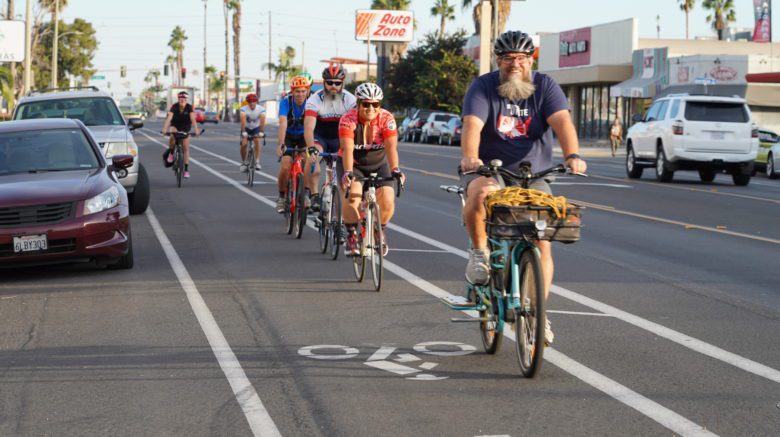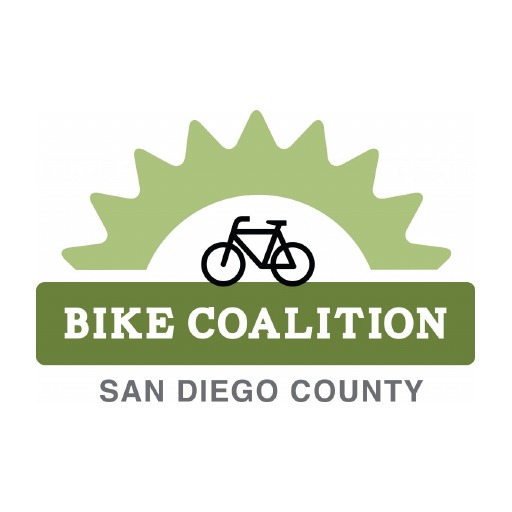By Marissa Tucker-Borquez
California, San Diego County, and local cities all made huge leaps forward on bicycling in 2021.
The City of San Diego took major leaps toward implementing its planned network of quick build cycling infrastructure. Washington Street, 30th Street, and Pershing Drive all received new paint and flex posts to create Class IV cycle tracks in rapid succession. While Washington Street and Pershing Drive were only upgraded after the death of several cyclists and micromobility users, 30th Street proved that such treatments can also be used proactively to prevent serious injuries and fatalities. The City committed to this new, proactive approach by dedicating just over $1M in funding to the new STAT (Safe and Sustainable Transportation for All Ages and Abilities) team which promises to develop at least nine miles of quick build facilities for people of all ages and abilities each year. We’ll be closely monitoring the work of the STAT team as this program comes to fruition.
Elsewhere in the County, Chula Vista opened up a buffered bike lane along one of its main commercial articles, Broadway, and Encinitas approved a new two-way cycletrack along the South Coast Highway 101.
SANDAG, San Diego’s Regional Transportation Agency, also had a busy year of opening new bikeways across the county. Ribbons were cut to open the Inland Rail Trail: Phase II, Chula Vista’s Sweetwater Bicycle Path and Promenade along the Bayshore Bikeway, and the much anticipated Rose Creek Bikeway connecting University City and Pacific Beach. The Georgia-Meade-Landis and 4th/5th Avenue Bikeways are nearing completion, with official ribbon cuttings expected within the next few weeks.
In December, SANDAG also passed its 2021 Regional Transportation Plan, the first active transportation and public transit forward plan in the San Diego region’s history. With that plan, SANDAG recommitted to the Early Action Program (EAP), a planned network of over 77 miles of bikeways that will link the region together, by allocating additional funding to prevent delays and account for increased construction costs. SANDAG also promised new City and County coordination to ensure these projects are completed more rapidly: the litmus test will be if they are able to complete the Pershing and Central Avenue bikeways by 2023.
At the State level, 2021 was a combination of huge steps forward and missed opportunities. Despite being approved by both the state senate and assemblies, two bills that would have decriminalized jaywalking and allowed cyclists to treat stop signs as yields were vetoed by Governor Gavin Newson. Yet in that same session, Governor Newson signed Assembly Bill 43, which allows municipalities to adjust speed limits to as low as 25 mph on residential roads. AB 43 could make the adoption of slow streets and bike boulevards much easier and safer, should local governments choose to take advantage of it.
Finally, Caltrans, the agency responsible for all of California’s state and interstate highways, passed a revolutionary complete streets resolution that will transform the process for building safe bike infrastructure on their right-of-way. The resolution states that “all transportation projects funded or overseen by Caltrans will provide comfortable, convenient, and connected complete streets facilities for people walking, biking, and taking transit or passenger rail unless an exception is documented and approved.”
For decades, Caltrans disrupted local bike networks by refusing to install bike facilities on sections of local roads that crossed their right-of-way. With this new policy, every Caltrans roadway will have a bike facility by default, meaning that state highways, which historically have been the last roadways to include bikeways, will now often be the first.
While so much positivity has happened in the world of bike advocacy in 2021, the pandemic of traffic violence still continues. 16 lives were lost this year in San Diego County for the simple act of cycling on public streets. Those deaths serve as a reminder that while some progress is being made, it has not been not enough. The Bike Coalition will keep fighting and advocating for immediate solutions that keep us all safe on our streets regardless of our choice of transportation.


